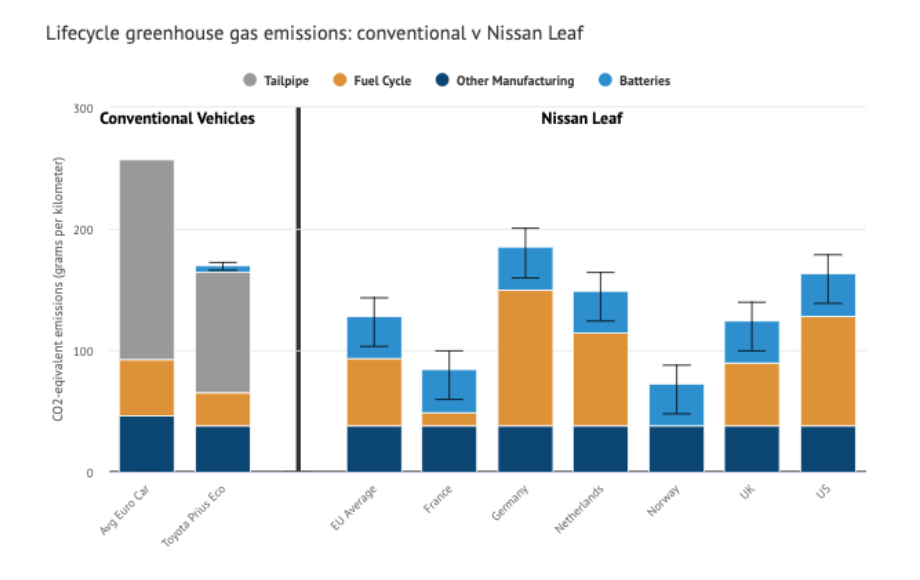Are Electric Vehicles Really The More Eco-friendly Option?

However, when evaluating the eco-friendliness of an electric vehicle, we also need to take the well to wheel emissions into account. This is an overarching term that includes greenhouse gas and air pollutants that are emitted to produce and distribute the energy being used to power the car. Electricity production results in a varying amount of emissions depending on the resource. While “being green” in the act of driving your electric vehicle is a start, if your primary goal in purchasing an electric vehicle is to reduce your greenhouse gas and pollutants emissions, you should also prioritize using zero-emissions electricity wherever possible.
When taking well-to-wheel emissions into account, all-electric vehicles emit an average of around 2018 kg of CO2 equivalent each year. By comparison, conventional petrol cars will emit over twice as much annually. Another benefit of electric cars is that they do not emit other air pollutants such as oxides of nitrogen which are a respiratory irritant.
Global warming emissions from driving an EV are not the full story. We must be attentive to the “bottom line”—the vehicle’s overall global warming emissions during its life cycle—which takes into account its operation, production, and disposal. The manufacture of EV batteries, for example, is of particular concern regarding global warming emissions. In addition batteries use a large quantity of lithium and cobalt – these materials come from less developed countries which operate harsh mining practices.
With the mass market penetration of electric vehicles, the Greenhouse Gas (GHG) emissions associated with lithium-ion battery production has become a major concern. In this study, by establishing a life cycle assessment framework, GHG emissions from the production of lithium-ion batteries in China are estimated. The results show that for the three types of most commonly used lithium-ion batteries, the (LFP) battery, the (NMC) battery and the (LMO) battery, the GHG emissions from the production of a 28 kWh battery are 3061 kgCO2e, 2912 kgCO2e and 2705 kgCO2e, respectively. This implies around a 30% increase in GHG emissions from vehicle production compared with conventional vehicles. The productions of cathode materials and wrought aluminium are the dominating contributors of GHG emissions, together accounting for around three quarters of total emissions from an electric car. From the perspective of process energy use, around 40% of total emissions are associated with electricity use.
The chart below compares regular vehicles with hybrid and electric cars. The second car is a Toyota Prius Hybrid (from https://www.eco-business.com/news/factcheck-how-electric-vehicles-help-to-tackle-climate-change/)
The emissions from an all-electric Nissan Leaf vary in different countries (this is due to the electricity network having different emission factors – for example, France and Norway sow the lowest emissions as their national electricity grids use large nuclear and hydro-electric generating stations. So where we run electric cars makes a difference to the actual emissions.
In short, where there are low national electricity grid emissions the electric vehicle produces lower emissions.
The map below shows how grid emission factors influence the total emissions of E cars versus petrol/diesel cars. The areas in red show that the actual GHG emissions are higher than that for a fossil-fueled car. A study in the USA concludes that West Virginia and Georgia in particular are locations where the GHG case for PEVs in our analysis is less strong since the gasoline-powered Prius HEV has lower life cycle GHG emissions there than either the Leaf BEV or the Volt PHEV. Thus we cannot say for sure that EVs are the answer to reducing mobility GHGs.
The increased use of electric cars will also create an increased demand for electricity to be generated (some say 20% more), which may create problems for balancing and even running the power grid especially given that peak EV charging times coincide with peak-heating demand in winter.
Business Insider Magazine reports “Yet building electric cars creates more greenhouse-gas emissions than producing an equivalent gas-powered vehicle” and the International Council on Clean Transportation have studied the life cycle impact associated with electric versus fossil-fueled cars – their results are shown at the table above.
Electric car manufacturing in China has shown that GHG emissions from the production of EVs is about 14.6 tonnes of GHG per vehicle. For the equivalent sized petrol car the GHG emissions are 9.1 tonnes of GHG per vehicle.
As electricity generation becomes less emissions-intensive – the life cycle GHG emissions of EVs should also become less intensive. However, there is still the sustainability of battery manufacturing being questioned. – As the world scrambles to replace fossil fuels with clean energy, the environmental impact of finding all the lithium required could become a major issue in its own right.
One of the biggest environmental problems caused by our endless hunger for the latest and smartest devices is a growing mineral crisis, particularly those needed to make our batteries,” says Christina Valimaki an analyst at Elsevier.
Lithium extraction in South America uses a brine extraction process which is a relatively cheap and effective process, but it uses a lot of water – approximately 500,000 gallons per tonne of lithium. In Chile’s Salar de Atacama, mining activities consumed 65 percent of the region’s water. That is having a big impact on local farmers – who grow quinoa and herd llamas – in an area where some communities already have to get water driven in from elsewhere (see here) and this report states:
“According to a report by Friends of the Earth, lithium extraction inevitably harms the soil and causes air contamination. In Argentina’s Salar de Hombre Muerto, locals claim that lithium operations have contaminated streams used by humans and livestock, and for crop irrigation. In Chile, there have been clashes between mining companies and local communities, who say that lithium mining is leaving the landscape marred by mountains of discarded salt and canals filled with contaminated water with an unnatural blue hue”
In Tibet, lithium extraction has caused fish kills in local waterways.
The Guardian reported. “Then there’s cobalt, another component of EV batteries. In addition to the environmental concerns related to lithium production, cobalt mining is unequivocally destructive on multiple levels. Currently, half of the world’s cobalt is produced in the Republic of Congo. Concerning cobalt mining in the Congo region, journalists have revealed human and environmental abuses ranging from child and slave labour, to toxic waste leakage and radioactivity in cobalt mines. “In 2014, according to UNICEF, about 40,000 children were working in mines across southern DRC, many of them extracting cobalt.
An article in late 2018 by Dirk Blijweert of Louvain University on the hidden costs of cobalt mining in the Democratic Republic of Congo states that
Children living in the mining district had 10 times as much cobalt in their urine as children living elsewhere. . . . we found more DNA damage in children living in the mining area than in those from the control group. And the preliminary results of an ongoing study suggest that miners’ newborn babies have an increased risk of birth defects.
See here for the full article.
The world’s most admired scientific journal Nature reports that cobalt mining in DRC leads to
. . . people living in a neighbourhood that had been transformed into an artisanal cobalt mine had much higher levels of cobalt in their urine and blood than people living in a nearby control area. The differences were most pronounced for children, in whom we also found evidence of exposure-related oxidative DNA damage. It was already known that industrial mining and processing of metals has led to severe environmental pollution in the region. This field study provides novel and robust empirical evidence that the artisanal extraction of cobalt that prevails in DR Congo may cause toxic harm to vulnerable communities. This strengthens the conclusion that the currently existing cobalt supply chain is not sustainable.
Therefore batteries for electric cars lead to significant damage in China, South America and Africa.
Similar Topics:


